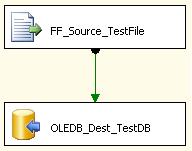Retain NULL values vs Keep NULLs in SSIS Dataflows - Which To Use? (转载)
There is some confusion as to what the various NULL settings all do in SSIS. In fact in one team where I worked we had created 15 packages before realising the full implications of the various default settings. Anyway, hopefully this article will help to clarify a bit......
Suppose you are doing a bog-standard import of a text file like the one below. We have a data flow task with a flat-file source going to a OLEDB destination. The flat file contains 3 columns: MyDate, MyInt and MyText. In the file there are 2 rows - one containing normal values and the other one just containing blank column values. So, what happens in the case of a blank value?

By default, what will happen is shown in the first dataset below (2nd row). A blank date will become "1st Jan 1753", an integer will become "0" and text will become "". Is this what you want? Usually not - especially if "0" is also a legitimate explicit numerical value in the text file!

So, we can designate that the null values from the flat file (really an absence of a value) will become a null in the resulting OLEDB destination. There is a little checkbox on the flat file source which controls this:

The imported dataset will now look like this:

So far so good.
However there is another similar setting available here. This is a checkbox on the OLEDB destination labelled as "Keep NULLs" - what is that for?
Basically this controls what happens when you have defaults on the destination table. If there is a default constraint on each column –
eg
the date should be today's date,
the number should be -1
the text "n/a"
- do we want these default values to be overwritten by NULL values or to simply apply their specified defaults?
The relevant option is shown below. In this particluar case the defaults won't get applied and will be overwritten by NULLs from the source file.

If it was unchecked, and the defaults mentioned above existed, we would arrive at the values below.

Hopefully this makes these 2 setting and the various permutations s a little clearer
Retain NULL values vs Keep NULLs in SSIS Dataflows - Which To Use? (转载)的更多相关文章
- MySQL :: MySQL 8.0 Reference Manual :: B.6.4.3 Problems with NULL Values https://dev.mysql.com/doc/refman/8.0/en/problems-with-null.html
MySQL :: MySQL 8.0 Reference Manual :: B.6.4.3 Problems with NULL Values https://dev.mysql.com/doc/r ...
- You can add an index on a column that can have NULL values if you are using the MyISAM, InnoDB, or MEMORY storage engine.
w https://dev.mysql.com/doc/refman/5.7/en/create-index.html MySQL :: MySQL 5.7 Reference Manual :: B ...
- SQL NULL Values
NULL代表缺失的.未知的数据.表的列值默认是NULL.如果某个表的某个列不是NOT NULL的,那么当我们插入新纪录.更新已存在的记录时,可以不用为此列赋值,这意味着那个列保存为NULL值. NUL ...
- NOT IN clause and NULL values
https://stackoverflow.com/questions/129077/not-in-clause-and-null-values This issue came up when I g ...
- Elasticsearch的null values
很多时候,我们需要面临null值的烦扰,查询es时传入null值是要查询出null的数据还是不查这个field呢,稍有不慎就会引发新的bug,这的确是个问题! null_value 意味着无法索引或搜 ...
- 微软BI 之SSIS 系列 - 对于平面文件中 NULL 值处理过程中容易极易混淆的几个细节
开篇介绍 最近有人问我有关文件处理中空值处理的相关问题: OLE DB Destination 中的 Keep Nulls 如何控制 NULL 值的显示? 为什么选中了 Keep Nulls 但是数据 ...
- 微软BI SSIS 2012 ETL 控件与案例精讲面试 200 问(SSIS 面试题,ETL 面试题)
开篇介绍 本自测与面试题出自 微软BI SSIS 2012 ETL 控件与案例精讲 (http://www.hellobi.com/course/21) 课程,对于学完本课程的每一课时和阅读完相关辅助 ...
- 微软BI SSIS 2012 ETL 控件与案例精讲课程学习方式与面试准备详解
开篇介绍 微软BI SSIS 2012 ETL 控件与案例精讲 (http://www.hellobi.com/course/21) 课程从2014年9月开始准备,到2014年12月在 天善BI学院 ...
- SSIS 自测题-文件操作类
说明:以下是自己的理解答案,不是标准的答案,如有不妥烦请指出. 有些题目暂时没有答案,有知道的请留言,互相学习,一起进步. 1.什么是控制流,什么是数据流,控制流和数据流之间的关系是什 ...
随机推荐
- 简介SWT Jface
可以使用标准窗口小部件工具箱(Standard Widget Toolkit,SWT)和 JFace 库来开发用于 Eclipse 环境的图形用户界面,而且还可以将它们用于开发单独的 GUI 本机应用 ...
- python制作 whl 源文件,并制作本地pip源
制作whl 1.创建用于存放wheel文件目录 mkdir wheels 2.安装wheel库 pip install wheel 3.进入wheels目录 cd wheels 4.使用pip wh ...
- Javascript 对象Object
1.new构造函数法 2.对象字面量 对象字面量很好理解,使用key/value的形式直接创建对象,简洁方便. 这种方式直接通过花括号将对象的属性包起来,使用key/value的方式创建对象属性, ...
- C#中三个关键字params,Ref,out
关于这三个关键字之前可以研究一下原本的一些操作 using System; using System.Collections.Generic; using System.Text; namespace ...
- Linux.net && mono
资料: http://www.cnblogs.com/xiaodiejinghong/archive/2013/04/01/2994216.html http://www.cnblogs.com/sh ...
- c++ sizeof对象大小整理
1. sizeof 是运算符,而不是函数. 2. 当sizeof 的对象是表达式时,求的大小是表达式返回值的类型大小,但并不计算表达式的值,比如: ; ; cout << sizeof(c ...
- Django组件——分页器(paginator)
一.视图层 from django.shortcuts import render # Create your views here. from .models import Book from dj ...
- 00字体图标iconfont的制作与使用--阿里矢量图库
一.iconfont的使用范围 在工作当中,经常会用到嵌在元素里的小图标 在这种情况下,如果使用<img>标签或者用作背景图片,也能实现这种效果.但是如果这么做的话,就必须把图片一个个切下 ...
- 菜鸟学习Spring——SpringMVC注解版将URL中的参数转成实体
一.概述 将URL中参数转成实体在我们项目中用的很多比如界面提交表单请求后台的Contorller的时候通过URL传递了一串参数到后台,后台通过Spring让界面的字段与实体的字段映射来实现给后台的实 ...
- linux定期任务cron
做个给服务器定期检测的python程序,要python跑起来自己检测时间再执行?我想到了用cron服务. 遇到了个问题python没写绝对路径,没有执行,改了绝对路径就好了.其实人家配置文件开头写了个 ...
